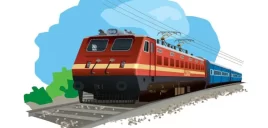Some WAP / WAM models have in-cab AWS / ATS (auxiliary warning system, automatic train stop). AWS provides prior in-cab notification of distant or home signals that are displaying danger or ‘on’. ATS provides for a locomotive to be brought to a halt in case it overshoots an ‘on’ signal that it should not have.
This has been tried out on the Mughalsarai-Howrah section (ER) but is not in wide use although it was installed in the 1980s. (Pilferage of the track equipment is said to have been one reason for slow adoption by the railways.) Some Mumbai-area suburban EMU routes of WR and CR have ATS and AWS systems (WR had AWS from the 1980s, while CR got it more recently, in 2000).
If a signal at Caution is passed at above 25km/h, a buzzer sounds in the cabin and the motorman has to respond within 15 seconds to avoid application of the emergency brakes. The system also halts the EMU rake if a signal at danger is passed. The lineside transmitter for this is placed in between the rails a short distance before the signal, and the receiver for this is placed on the leading truck of the loco. CR EMUs do not have this system [7/00] and run without its benefit on WR tracks.
AWS systems usually work by means of electromagnets placed on the track that are activated by the signal aspects and whose magnetic fields are sensed by the AWS sensor mounted on the loco. A variation of AWS is being tried out [6/02] on the Delhi-Mathura section where instead of using magnetic sensors a radio signal is used to activate the buzzer or other alerting device for the driver.
[11/99] A system of loco identification and automatic proximity alerts has been proposed for the Konkan Railway. In this scheme, each loco would carry a beacon that transmitted its identification, including the train number, direction, etc. Ground-based receivers would pick up the beacon signals and relay the information to traffic control centres. Also, if there were other locos within a short distance (2km?) with the same beacon system, an alert would sound in the loco cab. This same system (or a similar one?) is also to be introduced on NFR [7/00].
Anti-collision devices (ACD) that will bring a train to a halt if it is within a certain distance to another train on the same tracks have also been proposed [7/01]. These were developed by Konkan Railway. These depend on computing the ‘crossing number’, a measure that takes into account the converging and diverging routes encountered by a train in order to figure out whether two trains that appear dangerously close (detected by means of radio beacons) are in fact safe because they are on different adjacent tracks, or not. ACD deployment began on Konkan Railway and now [12/04] there are plans to use them on nearly 3,500 route-km of NR, NFR, SR, SCR, and SWR.
Some WCAM-1 locos have a transceiver that is supposed to alert the driver of a derailment or other problem ahead. Very few locos seem to be equipped with this. [1/00] A version of ATP using Siemens ZUB equipment has been deployed in portions of the Calcutta and Bombay suburban systems. (How extensive is this?)
[4/00] IR is looking into procuring ETCS level 2 equipment to be installed on the trunk lines betweeen the four major metropolises, and later on other main lines. ETCS level 2 equipment allows for communication of target speeds, safe braking distances, etc. from lineside equipment to the on-board computers of the loco. It includes a measure of ATP (Automatic train protection) in that it can slow down or stop a train if required when the driver exceeds the safe speeds for given signal aspects; but it does not include full ATC (automatic train control).
[4/00] A pilot ETCS installation for an 84km stretch of the Delhi-Mathura line is planned with 40 locomotives to be fitted with the equipment.
[2/01] A system of ATC is being tried out for the Calcutta Metro. When deployed (expected some time in 2001) this will allow for automated routine operations, and reduced headway of 8 or even 5 minutes between the trains (currently headway is 10 minutes on the metro).
[6/03] The Delhi Metro uses in-cab signalling and is planning the use of ATC / ATO operation of the subway trains.
Mobile Trunk Radio Communications (MTRC) is used on some sections (Bhusawal – Itarsi, Itarsi – Nagpur, Nagpur – Durg). This is an older analog system dating to the 1980s, which allows the Traction Loco Controller to talk by radio to train crew that are carrying a receiver with them in the locomotive cab. Digital versions of MTRC have been considered and are slated for trials soon [2/05].
[12/04] IR is also considering the use of GSM-R technology on parts of its network. Siemens AG is supplying GSM-R equipment for 700 route-km of the NFR in West Bengal, Assam, and Bihar as an initial project for IR to experiment with the technology. [5/05] The North Central and East Central zones are also setting up some GSM-R services. GSM-R is a set of standards for railway-specific communications, integrating voice, data, and control communications, which is based on the popular GSM standard for mobile telephone communications.
[5/05] A Train Protection and Warning System (TPWS), based on ETCS Level 1 has been proposed for the Chennai Beach – Gummidipoondi section. EMUs will be monitored using track balises and lineside transmission devices (LEU or Lineside Electronic Unit). Signal aspects will be available in the EMU cab, and EMUs will be automatically braked if its speed is in excess of the safe speed appropriate for the signal aspect.
Anti-collision Device (ACD) Konkan Railway has developed a system involving radio receivers and transmitters fitted on locomotives, which aims to prevent or minimize the chances of collisions. The transmitter sends out a coded signal that identifies the train and its direction, route, etc.
Proximity and directional sensors and circuitry to handle the train identification information from other transmitters in the vicinity allows the ACD to sound an alarm and/or apply the brakes if it discovers that two trains have been routed on to the same track. Some versions of the ACD are also said to include the use of GPS to provide accurate information on the location of each train.
The ACD equipment has been put to use in several sections. It has been claimd [6/03] that equipment-related accidents have gone down substantially in the Jalandhar-Amritsar section because of ACDs.
Some zones of IR have recently [12/04] been experimenting with using GPS to report train positions and expected arrival times, etc.
Source – IFRCA.org
This entry was posted in 2 Railway Employee, STUDY NEW, Railway Employee











